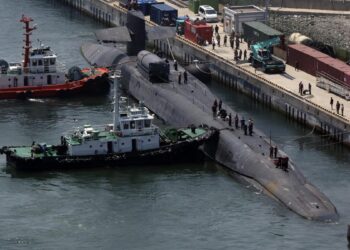[ad_1]
With the dissolution of Punjab and the Khyber Pakhtunkhwa (KP) provincial assemblies, Pakistan’s politics has entered tumultuous territory. Former Prime Minister and founder of the Pakistan Tehreek-e-Insaf (PTI) Imran Khan believes that now the PTI has a better chance to return with more seats. On the contrary, the Pakistan Muslim League (Nawaz) (PML-N) and the Pakistan Democratic Movement (PDM) have been trying to avoid holding elections immediately. They want more time to stabilise the economy and improve social conditions before asking the people to vote. However, Mr. Khan senses a public mood against the Establishment and wants to capitalise on it. The PDM would want to strengthen its case with the Establishment firmly, before making the next step. The economic situation and the social conditions following the floods remain tense in Pakistan. All of the above, along with the lack of political consensus leaves national politics in a flux. At the same time, in the provincial level, there is an effort to revamp regional political parties in Balochistan and Sindh.
The race for Punjab
For the PML-N, winning Punjab is important to come back to Islamabad; preventing the Sharifs from doing so is the primary task for the PTI. Mr. Khan is now batting without the support of the Establishment; for him, the latter is no more a neutral umpire. He is pursuing confrontational politics; perhaps in the hopes of making Punjab volatile. The province is the most populous and politically powerful in the country. The party that controls Punjab will control Pakistan. The PML-N leads Parliament but has failed to capture the Punjab provincial assembly.
Of the 342 seats in the National Assembly, 272 are directly elected, and 70 are reserved for women and minorities. Put together (the open and reserved seats), Punjab alone has 173 seats, followed by Sindh (75), KP (55), and Balochistan (20). All that a party needs to have a majority in Parliament is 172 seats; in paper, if a party wins all the seats from Punjab for the National Assembly, and does not have a single seat from the other three provinces, it may still be able to form the government in Islamabad.
Therefore, the Punjab province holds the key for both PTI and PML-N. For the PTI, the 2018 election in Punjab was a miracle. The Establishment’s backing was considered as a primary reason for the win. Secondly, the Tehreek-e-Labbaik Pakistan (TLP), then a new Brelvi religious party, floated just before the elections, ate into the PML-N share in Punjab. Though the TLP could not win a single seat for the National Assembly, it spoiled the chances for PML-N in many constituencies, thereby providing space to the PTI. The PML-N has to win the hearts and minds of the people of the Punjab province first, but the current economic situation does not provide adequate space to do so. This is why Pakistan Prime Minister Shehbaz Sharif wants more time to hold elections.
In terms of internal party divide, both the PML-N and PTI have problems. For the PML-N, the two star campaigners — Nawaz Sharif and Maryam Nawaz are not in the country. It is also imperative to prove that all is well within the Sharif family. There are rumours about a divide between the Sharif brothers, and also between their siblings — Maryam Nawaz and Hamza Shabaz. For the PTI, a section starting from Jahangir Tareen has left the party. There is an effort to form a third front with them; the Pakistan Peoples Party (PPP) also seems to be winning their support, so that it can have its presence in south Punjab.
In all of this, where does the TLP stand? What will be its political calculation? In the past, it has not been shy to use violence to make its presence felt in Punjab.
The wrestle in Karachi
Sindh politics, outside Karachi, seems to be with the PPP. Zardari has succeeded in keeping the party together and therefore, rural Sindh remains with the PPP. Karachi is the primary puzzle in Sindh. The city of lights has around 20 seats for the National Assembly, and 40 plus seats for the Sindh provincial assembly. The Muttahida Qaumi Movement (MQM) used to have the larger share of the above, but the 2018 election witnessed PTI taking over the lion’s share in Karachi. The Pashtun population, and a section of the middle class is believed to have shifted to the PTI in Karachi.
The bigger political question in Karachi has been the MQM fragmentation. The deep state by 2018 had succeeded in making the party into MQM-minus Altaf Hussain (Altaf Hussain is known as the founder of the MQM). The process also resulted in the party getting fragmented into three factions — MQM-P (led by Khalid Maqbool Siddiqui), Pakistan Sarzameen Party (led by Syed Mustafa Kamal), and the third one headed by Farooq Sattar. Last week, mediated by Sindh Governor Kamran Tessori, all three factions have come together. Two reasons are being projected for this reunification. One, the realisation that they have lost their bargaining power both at the national and provincial level, and the rise of PTI as a common threat. Two, a general perception, that the deep state is behind the reunification process. It is said that the deep state wanted to remove Altaf Hussain from Karachi’s politics and thereby remove MQM’s hold over the city. It succeeded in both — it forced Altaf Hussain out of Karachi and got Imran Khan in. Now, the deep state, it is argued, would want the MQM to be back, to keep Mr. Khan out.
The PTI would be the loser in the above discord in Karachi. The PPP may retain its control over rest the of the Sindh; and the MQM may win the city back, if the factions remain united. If not, religious parties from Jamaat-e-Islami to the latest entrant, the TLP, may find a space. But, how would Mr. Khan, with a substantial Pashtun following in Karachi respond to the above developments?
A highly fragmented Balochistan
Balochistan politics is also in a state of flux. This is due to the fragmentation of regional political parties, and the failure of national parties to find any reasonable space in provincial politics. None of the regional parties led by the Sardars could find a larger space nor could they unite the people with a pan-Baloch appeal.
As a result, provincial politics remain fragmented, and the deep state does not have to do much. Of all the engineering that happened around 2018, the formation of the Balochistan Awami Party (BAP) has been the easiest. The party came into being overnight, succeeded in forming the government in Balochistan, and became a coalition member of the PTI. During the last two weeks, members of the BAP have been joining the PPP; Jamiat Ulema-e-Islam (F) (JUI-F) has also been witnessing a revival in the province, with some of the Baloch leaders joining the party. The end game here has not been clear so far.
The provincial politics here may not have much of an affect nationally. There are only 20 seats for the National Assembly from Balochistan. But, it may impinge on provincial politics. In Gwadar, there is a middle-class movement outside tribal politics taking shape. In the heart and west of the province, a slow-burn insurgency is on the rise led by Baloch militants. In the north, the Pashtun ingress into Balochistan from KP and Afghanistan continues, though politically they are divided, as could be seen from the Pashtunkhwa Milli Awami Party (PkMAP). There is a divide within the PkMAP, which can be seen from the recent splits, expulsions and related factional strife. The three sub-regions of the province are in different forms and stages of flux.
The stronghold
Of all the four provinces, the most stable politically is the Khyber Pakhtunkhwa. Mr. Khan is confident that his fort is holding, and that the PTI would win the province again. His confidence stems from the fact that none of the other parties are strong enough. The Awami National Party (ANP) which ruled the province from the days of the Khan brothers, PPP, PML-N and religious parties – all have declined during recent decades.
However, a threat to Mr. Khan’s confidence could come from the young tribal uprising led by the Pashtun Tahaffuz Movement, and the violence unleashed by the Tehreek-e-Taliban Pakistan (TTP) in the tribal regions. The first one is a socio-political movement demanding a new space for Pashtun youth; and the second one is a murderous terrorist organisation with whom Mr. Khan sympathised in the past.
Where is the political flux heading?
Political actors are getting ready to face the election this year. This is likely to make the situation unstable in the near future. The second reason for the flux is the change in the deep state’s preference.
During the previous election, it decided to bring Imran Khan into the centre and propped the provinces to that goal. Political engineering in Punjab, Karachi and Balochistan were a part of the above design in 2018. Today, the situation is different, and stands reversed. Whether the deep state is with the PML-N or not is unclear but it is definitely not with Mr. Khan. Will it remain neutral? Contrary to the statements made by the outgoing army chief that the Establishment should stay out of politics, recent developments convey a different story.
Will Mr. Khan accept the emerging political situation, and the follow-up results, especially, if it is not in his favour? The possibility of Mr. Khan taking a confrontational position, and even boycotting the process cannot be overruled.
In any case, his recent decisions convey that he would not be likely to play by the rules.
D. Suba Chandran is Dean, School of Conflict and Security Studies at the National Institute of Advanced Studies (NIAS), Bengaluru
[ad_2]
[ad_1]
With the dissolution of Punjab and the Khyber Pakhtunkhwa (KP) provincial assemblies, Pakistan’s politics has entered tumultuous territory. Former Prime Minister and founder of the Pakistan Tehreek-e-Insaf (PTI) Imran Khan believes that now the PTI has a better chance to return with more seats. On the contrary, the Pakistan Muslim League (Nawaz) (PML-N) and the Pakistan Democratic Movement (PDM) have been trying to avoid holding elections immediately. They want more time to stabilise the economy and improve social conditions before asking the people to vote. However, Mr. Khan senses a public mood against the Establishment and wants to capitalise on it. The PDM would want to strengthen its case with the Establishment firmly, before making the next step. The economic situation and the social conditions following the floods remain tense in Pakistan. All of the above, along with the lack of political consensus leaves national politics in a flux. At the same time, in the provincial level, there is an effort to revamp regional political parties in Balochistan and Sindh.
The race for Punjab
For the PML-N, winning Punjab is important to come back to Islamabad; preventing the Sharifs from doing so is the primary task for the PTI. Mr. Khan is now batting without the support of the Establishment; for him, the latter is no more a neutral umpire. He is pursuing confrontational politics; perhaps in the hopes of making Punjab volatile. The province is the most populous and politically powerful in the country. The party that controls Punjab will control Pakistan. The PML-N leads Parliament but has failed to capture the Punjab provincial assembly.
Of the 342 seats in the National Assembly, 272 are directly elected, and 70 are reserved for women and minorities. Put together (the open and reserved seats), Punjab alone has 173 seats, followed by Sindh (75), KP (55), and Balochistan (20). All that a party needs to have a majority in Parliament is 172 seats; in paper, if a party wins all the seats from Punjab for the National Assembly, and does not have a single seat from the other three provinces, it may still be able to form the government in Islamabad.
Therefore, the Punjab province holds the key for both PTI and PML-N. For the PTI, the 2018 election in Punjab was a miracle. The Establishment’s backing was considered as a primary reason for the win. Secondly, the Tehreek-e-Labbaik Pakistan (TLP), then a new Brelvi religious party, floated just before the elections, ate into the PML-N share in Punjab. Though the TLP could not win a single seat for the National Assembly, it spoiled the chances for PML-N in many constituencies, thereby providing space to the PTI. The PML-N has to win the hearts and minds of the people of the Punjab province first, but the current economic situation does not provide adequate space to do so. This is why Pakistan Prime Minister Shehbaz Sharif wants more time to hold elections.
In terms of internal party divide, both the PML-N and PTI have problems. For the PML-N, the two star campaigners — Nawaz Sharif and Maryam Nawaz are not in the country. It is also imperative to prove that all is well within the Sharif family. There are rumours about a divide between the Sharif brothers, and also between their siblings — Maryam Nawaz and Hamza Shabaz. For the PTI, a section starting from Jahangir Tareen has left the party. There is an effort to form a third front with them; the Pakistan Peoples Party (PPP) also seems to be winning their support, so that it can have its presence in south Punjab.
In all of this, where does the TLP stand? What will be its political calculation? In the past, it has not been shy to use violence to make its presence felt in Punjab.
The wrestle in Karachi
Sindh politics, outside Karachi, seems to be with the PPP. Zardari has succeeded in keeping the party together and therefore, rural Sindh remains with the PPP. Karachi is the primary puzzle in Sindh. The city of lights has around 20 seats for the National Assembly, and 40 plus seats for the Sindh provincial assembly. The Muttahida Qaumi Movement (MQM) used to have the larger share of the above, but the 2018 election witnessed PTI taking over the lion’s share in Karachi. The Pashtun population, and a section of the middle class is believed to have shifted to the PTI in Karachi.
The bigger political question in Karachi has been the MQM fragmentation. The deep state by 2018 had succeeded in making the party into MQM-minus Altaf Hussain (Altaf Hussain is known as the founder of the MQM). The process also resulted in the party getting fragmented into three factions — MQM-P (led by Khalid Maqbool Siddiqui), Pakistan Sarzameen Party (led by Syed Mustafa Kamal), and the third one headed by Farooq Sattar. Last week, mediated by Sindh Governor Kamran Tessori, all three factions have come together. Two reasons are being projected for this reunification. One, the realisation that they have lost their bargaining power both at the national and provincial level, and the rise of PTI as a common threat. Two, a general perception, that the deep state is behind the reunification process. It is said that the deep state wanted to remove Altaf Hussain from Karachi’s politics and thereby remove MQM’s hold over the city. It succeeded in both — it forced Altaf Hussain out of Karachi and got Imran Khan in. Now, the deep state, it is argued, would want the MQM to be back, to keep Mr. Khan out.
The PTI would be the loser in the above discord in Karachi. The PPP may retain its control over rest the of the Sindh; and the MQM may win the city back, if the factions remain united. If not, religious parties from Jamaat-e-Islami to the latest entrant, the TLP, may find a space. But, how would Mr. Khan, with a substantial Pashtun following in Karachi respond to the above developments?
A highly fragmented Balochistan
Balochistan politics is also in a state of flux. This is due to the fragmentation of regional political parties, and the failure of national parties to find any reasonable space in provincial politics. None of the regional parties led by the Sardars could find a larger space nor could they unite the people with a pan-Baloch appeal.
As a result, provincial politics remain fragmented, and the deep state does not have to do much. Of all the engineering that happened around 2018, the formation of the Balochistan Awami Party (BAP) has been the easiest. The party came into being overnight, succeeded in forming the government in Balochistan, and became a coalition member of the PTI. During the last two weeks, members of the BAP have been joining the PPP; Jamiat Ulema-e-Islam (F) (JUI-F) has also been witnessing a revival in the province, with some of the Baloch leaders joining the party. The end game here has not been clear so far.
The provincial politics here may not have much of an affect nationally. There are only 20 seats for the National Assembly from Balochistan. But, it may impinge on provincial politics. In Gwadar, there is a middle-class movement outside tribal politics taking shape. In the heart and west of the province, a slow-burn insurgency is on the rise led by Baloch militants. In the north, the Pashtun ingress into Balochistan from KP and Afghanistan continues, though politically they are divided, as could be seen from the Pashtunkhwa Milli Awami Party (PkMAP). There is a divide within the PkMAP, which can be seen from the recent splits, expulsions and related factional strife. The three sub-regions of the province are in different forms and stages of flux.
The stronghold
Of all the four provinces, the most stable politically is the Khyber Pakhtunkhwa. Mr. Khan is confident that his fort is holding, and that the PTI would win the province again. His confidence stems from the fact that none of the other parties are strong enough. The Awami National Party (ANP) which ruled the province from the days of the Khan brothers, PPP, PML-N and religious parties – all have declined during recent decades.
However, a threat to Mr. Khan’s confidence could come from the young tribal uprising led by the Pashtun Tahaffuz Movement, and the violence unleashed by the Tehreek-e-Taliban Pakistan (TTP) in the tribal regions. The first one is a socio-political movement demanding a new space for Pashtun youth; and the second one is a murderous terrorist organisation with whom Mr. Khan sympathised in the past.
Where is the political flux heading?
Political actors are getting ready to face the election this year. This is likely to make the situation unstable in the near future. The second reason for the flux is the change in the deep state’s preference.
During the previous election, it decided to bring Imran Khan into the centre and propped the provinces to that goal. Political engineering in Punjab, Karachi and Balochistan were a part of the above design in 2018. Today, the situation is different, and stands reversed. Whether the deep state is with the PML-N or not is unclear but it is definitely not with Mr. Khan. Will it remain neutral? Contrary to the statements made by the outgoing army chief that the Establishment should stay out of politics, recent developments convey a different story.
Will Mr. Khan accept the emerging political situation, and the follow-up results, especially, if it is not in his favour? The possibility of Mr. Khan taking a confrontational position, and even boycotting the process cannot be overruled.
In any case, his recent decisions convey that he would not be likely to play by the rules.
D. Suba Chandran is Dean, School of Conflict and Security Studies at the National Institute of Advanced Studies (NIAS), Bengaluru
[ad_2]
















